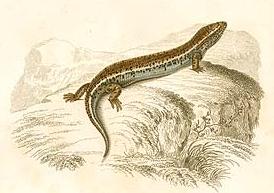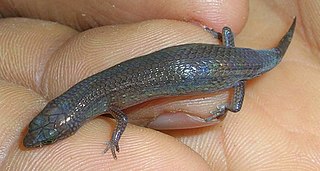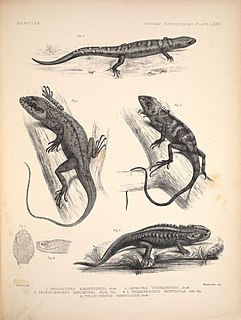
Brachymeles is a genus of skinks. Majority of the species within the genus are endemic to certain island ecosystems in the Philippines. In 2018, the Zoological Society of London through its EDGE of Existence Program listed the Cebu small worm skink as the 80th most evolutionarily distinct and globally endangered reptile species in the world, making it the most endangered member of the genus Brachymeles.

Chalcides is a genus of skinks.

Chioninia coctei, also called the Cape Verde giant skink, Bibron's skink, lagarto, or Cocteau's skink, is a species of lizard, a reptile that was at one time known to inhabit the islets of Branco and Raso in the Cape Verde islands of the Atlantic Ocean, rendered deserts by human-caused habitat destruction. None have been observed since the early 20th century.

Morethia is a skink genus of the order Squamata, commonly called Morethia skinks or firetail skinks, found in Australia.

Ophiomorus is a genus of Old World skinks.

Ristella is a genus of skinks endemic to the Western Ghats of southwestern India. They are commonly known as cat skinks because of their retractile claws. This genus can be instantly identified by the presence of only four fingers in forelimbs in all the species. All the members look more or less similar and are drab dark brown to blackish in complexion with paler undersides. This poorly known groups of lizards are diurnal, insectivorous, terrestrial to semi fossorial in habits. They inhabit deep leaf-litter and grasslands in montane forests and rainforests.

Tropidophorus is a genus of semiaquatic lizards in the skink family (Scincidae), found in Indochina, Borneo, Sulawesi, and the Philippines. They are sometimes known as water skinks or waterside skinks.
Dibamus is a genus of legless lizards in the family Dibamidae.

The Amphisbaenidae, common name worm lizards, are a family of amphisbaenians, a group of limbless vertebrates.
Eutropis beddomei, commonly known as Beddome's skink, is a species of skink endemic to India and Sri Lanka.

Eutropis multifasciata, commonly known as the East Indian brown mabuya, many-lined sun skink, many-striped skink, common sun skink or (ambiguously) as golden skink, is a species of skink.

Trachylepis is a skink genus in the subfamily Lygosominae found mainly in Africa. Its members were formerly included in the "wastebin taxon" Mabuya, and for some time in Euprepis. As defined today, Trachylepis contains the clade of Afro-Malagasy mabuyas. The genus also contains a species from the Brazilian island of Fernando de Noronha, T. atlantica, and may occur in mainland South America with Trachylepis tschudii and Trachylepis maculata, both poorly known and enigmatic. The ancestors of T. atlantica are believed to have rafted across the Atlantic from Africa during the last 9 million years.
Scincinae is a subfamily of lizards. The subfamily contains 33 genera, and the genera contain a combined total of 284 species, commonly called skinks. The systematics is at times controversial. The group is probably paraphyletic. It is one of three subfamilies of the family Scincidae, the other two being Acontinae and Lygosominae.

Eutropis is a genus of skinks belonging to the subfamily Lygosominae. For long, this genus was included in the "wastebin taxon" Mabuya; it contains the Asian mabuyas. They often share their habitat with the related common skinks (Sphenomorphus), but they do not compete significantly as their ecological niches differ.

The Noronha skink is a species of skink from the island of Fernando de Noronha off northeastern Brazil. It is covered with dark and light spots on the upperparts and is usually about 7 to 10 cm in length. The tail is long and muscular, but breaks off easily. Very common throughout Fernando de Noronha, it is an opportunistic feeder, eating both insects and plant material, including nectar from the Erythrina velutina tree, as well as other material ranging from cookie crumbs to eggs of its own species. Introduced predators such as feral cats prey on it and several parasitic worms infect it.
Trachylepis tschudii is an enigmatic skink, purportedly from Peru. First described in 1845 on the basis of a single specimen, it may be the same as the Noronha skink (T. atlantica) from Fernando de Noronha, off northeastern Brazil. T. tschudii represents one of two doubtful records of the otherwise African genus Trachylepis on mainland South America; the other is T. maculata from Guyana.
Chioninia delalandii is a species of skink, a lizard in the family Scincidae. The species is endemic to the Cape Verde Islands.
Chioninia nicolauensis is a species of skinks in the family Scincidae. It is endemic to the Cape Verde island of São Nicolau. Until around 2010, it was treated as a subspecies of Chioninia fogoensis.












